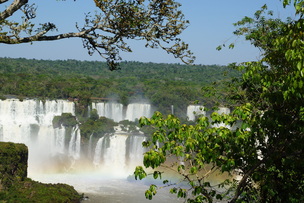
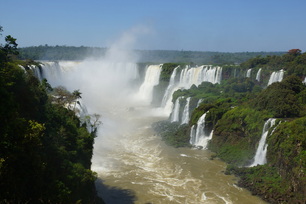
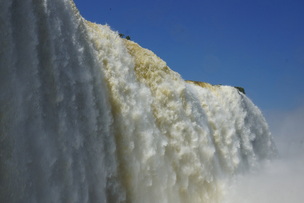
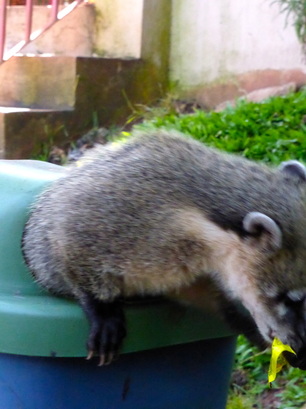
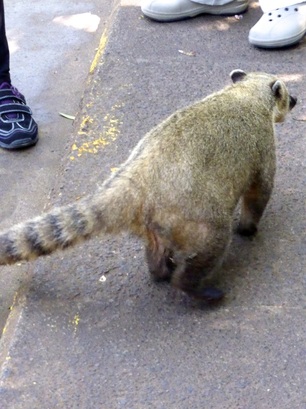
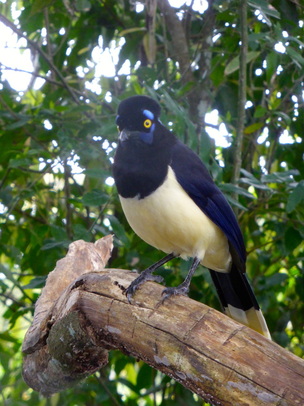
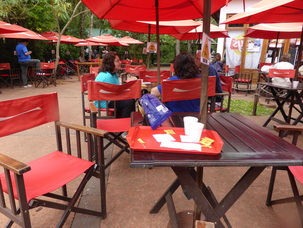
| The Motorhome Diaries |
|
 Iguazu Falls straddle Brazil and Argentina with 80% falling within Argentina. If you go then you need to see the falls from both countries.  Both countries run a pretty efficient operation in order to get the tourists in and around the various viewing platforms. In Argentina's case this is probably because it is the no. 1 tourist destination.  Water flow is 1750 cubic metres per second up to 39000 cubic metres if there is particularly heavy rainfall.  Not just water here either. This coati raided the litter bins for food. The way he climbed in suggested that this was a regular party trick.  These animals walk on the footpaths hoping to find someone willing to give them food.  This gorgeous bird (plush crested jay) is also a great scavenger and hang around the cafes hoping for titbits.  This one struck lucky with an empty crisp packet. We have had a splendid few days here and its been a great ending to a fabulous trip. Tomorrow we go back to Buenos Aires and a farewell dinner and Tango night and then its back home.
2 Comments
We have not had sufficient wifi to update this blog as often as we would have liked. We are back in Buenos Aires now and the hotel wifi is ok. So below are some pix from our recent travels. 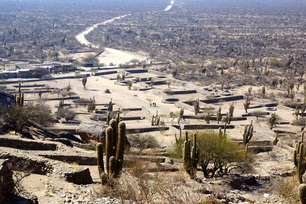 This is Quilmes a pre Inca settlement. An impressive set of ruins of a fortified village. 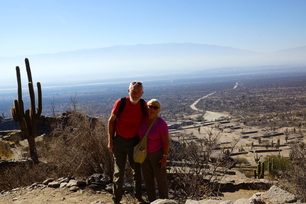 Another view of Quilmes and you can appreciate the strategic location. 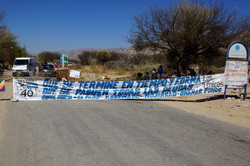 After leaving Quilmes, we came across a roadblock created by disillusioned locals who are out of work. All very civilised, we even got a free meal from them. Locro, a stew with meat and corn. All very civilised. 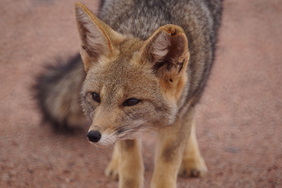 At the national park in Talampaya were these foxes. We counted about 12, they liked the bread I gave them in order to take this photo. 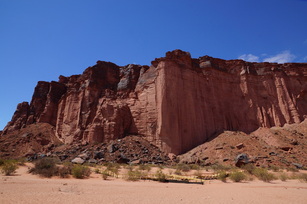 Huge dramatic cliffs. 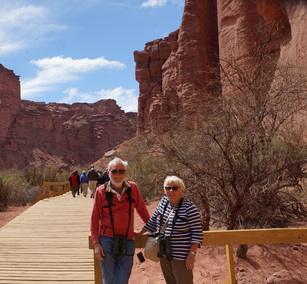 Talampaya is famous for its rock formations and is also where they have also found evidence of dinasaurs from the Triassic period 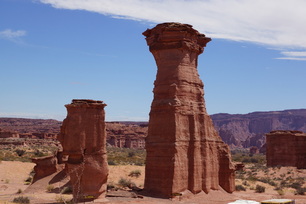 Weird rock formations 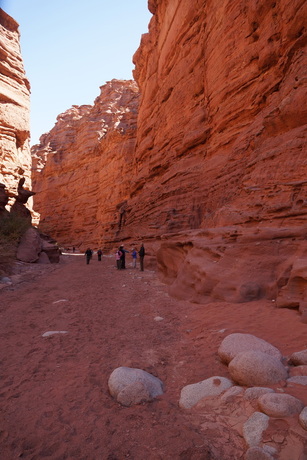 The narrow valley. 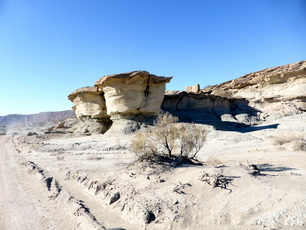 These next photos are from another national park called Valle de la Luna. A barren landscape as you can see. 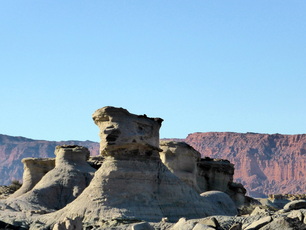 I thought this looked like the sphinx. 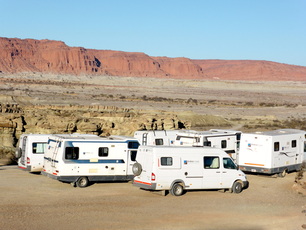 The roads here were really really bumpy and we were all certain we would never have taken our own motorhomes here. The hire vehicles were pretty rugged though. 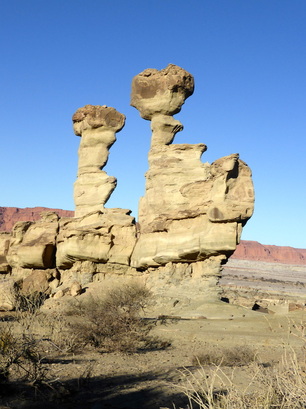 This was nicknamed the submarine - can't see it myself. 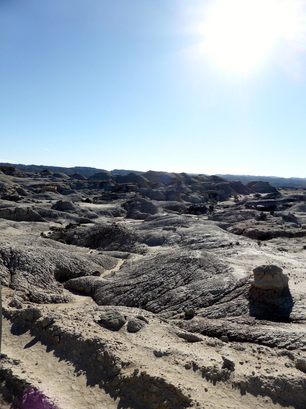 A bleak landscape where dinosaur fossils had been found. 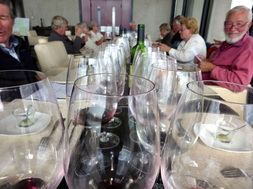 Great day winetasting in Uco valley. 5 glasses for 14 people means an awful lot of washing up. Fabulous six course tasting menu - Gilroy had to explain to his Swiss neighbour what sweetbreads were. 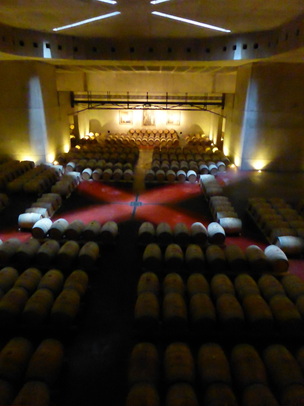 In the cellar. The red cross is natural light streaming down from the gardens above. This was a boutique winery and obviously a lot of money had been spent here. The wine was excellent. 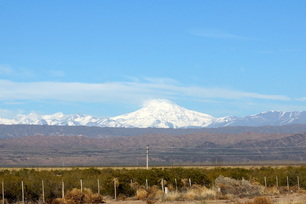 Aconcagua - the highest mountain in the Americas. 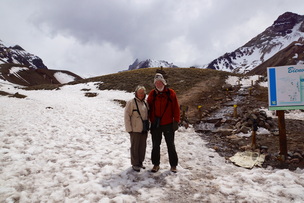 As you can see it was cold and it snowed. 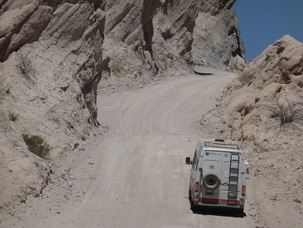 Ruta 40 goes the length of South America. We only did about 180 kms of it but it was probably one of the most scenic parts if not the roughest. Lots of blind bends, narrow bridges, cliff edges and traffic coming the other way - in our case a big yellow bus that took no prisoners as well as a lorry and a couple of ambulances. Having said that, we did not come across any accidents which here in Argentina is unusual. Today in Cafayate we met a German who is in a big Winnebago and he too came down that road - scary. Our next trip takes us further down the Ruta 40 but I think that this time there is tar. One of the big attractions here in Salta is to take the train up the mountains to San Antonio de Los Cobres.the train was built to service the mining industry & goes through 21 tunnels, over 29 bridges and across13 viaducts. Unfortunately a ticket cost about £120 and most of our group felt that was simply too much. Instead we hired a mini bus and driver and guide and followed the route of the train by travelling the Carretera a las Nubes. It also cost a fraction of the train price. Our journey took us up to 13845ft and once again we passed through amazing scenery through the Eastern Andes onto the Alto Plano,- the flatter area between the Western and Eastern Andes, also called the Puna.
From Salta we took an interesting route through cloud forest to Tilcarà which is in a mountainous area close to the Chilean and Bolivian borders. On the way we came across a road block of striking workers but a helpful local showed us a way around the blockage. This is the second time we have been affected by strikes, the first was when the bus drivers went on strike during our day trip to Cordoba. We are in an area known as the Quebrada de Humahuaca and is a World Heritage Site (so there's another ticked off that list). The scenery here is breathtaking with wonderfully coloured rocks and strange formations weathered by the wind which gets pretty fierce by midday. Tilcara is a bustling dusty town, it attracts tourists to the area and the little market is a spectacle of colour from the blankets, hats bags etc which are on sale here.there are bars and restaurants and most exciting of all a laundrette, we took our mudstained jeans (our muddy saga we will save for another day) and towels in there, it will cost about £3. About 70 kms from here are large salt flats and we attempted to visit these today but our van does not like going above 3000 metres and the road climbs by increasingly tight turns (see photo) above from 2,400m to 4000m. Warning lights came on and the engine began to make horrid noises as it lost power at altitude so we felt it best to turn back. Only slightly disappointed as we enjoyed the most breathtaking scenery, and as we had gone out early visibility was good so the camera got a good thrashing. We ended our trip by trying llama empanadas for lunch in another dusty adobe town called Purmamarca. They were delicious. Finally a word about the weather up here - really really cold. No heater in van and this morning not only outside of windscreen frozen but also the inside. Fortunately the duvet that came with the van is very thick.
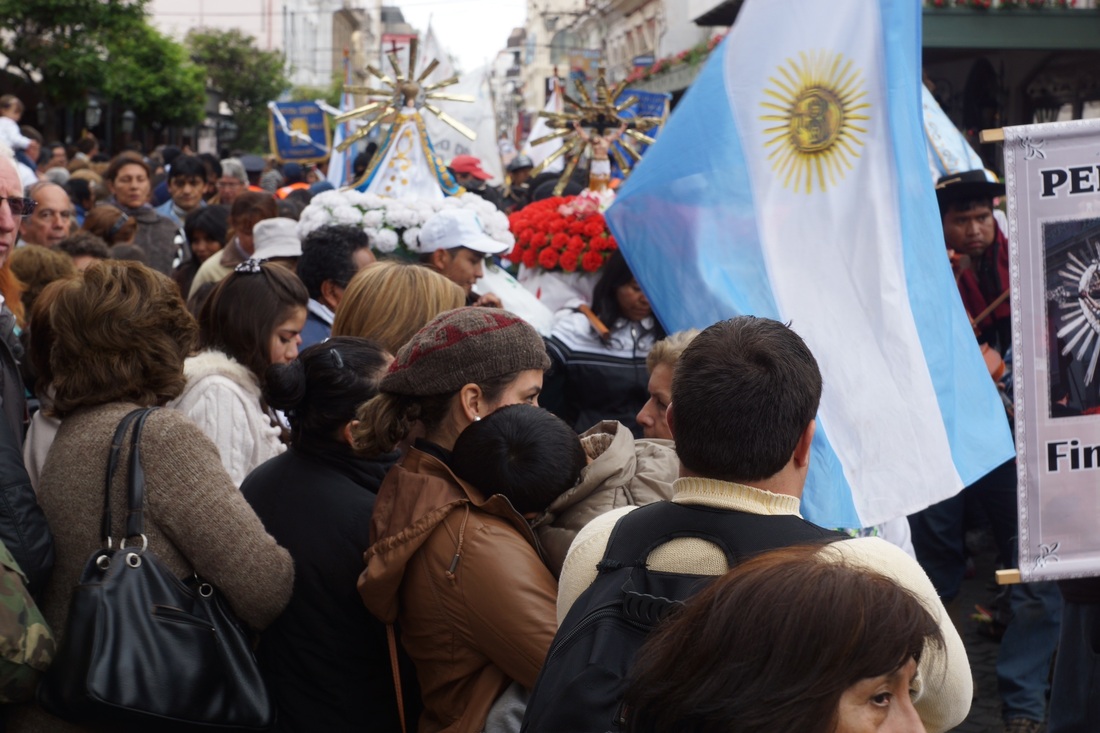 So, a week after picking up our motorhome and some 1500 Kms from Buenos Aires we arrived yesterday in Salta which is around 4,000 ft above sea level and close to the Andes. In fact we are much nearer the Pacific than to the Atlantic now. We came here a day earlier than planned and joined thousands of pilgrims who were coming here for the Semana del Milagro, or Miracle Week. In 1962 there was an earthquake and it was felt that it was a miracle that more homes were not damaged for which the Virgin has been given credit. As we approached the town there were walkers, cyclists, pickups and big old saloon cars with madonnas or crucifixes atop. A very jolly scene as the locals had set up feeding stations so the walkers could have drinks and food and at one point there was a small group singing and clapping as walkers came by. As we stopped to look they started singing to us - bienvenidos touristas. how did they know we were tourists? We are very very pale in comparison to everyone else as many people here are native Indian people. Our campsite, Camping Carlos Xamena is described in Lonely Planet as probably the best campsite in Argentina, perhaps it was the case in the past but it's a bit tired now and I don't think Lonely Planet have checked recently either. When we arrived it was packed with pilgrims all picnicking and preparing for their final walk up to the cathedral and we rather doubted if we would find space for our seven vans but it was fine and we settled in amongst the crowds the barbecues and the noise. As it happened these pilgrims were setting off soon after and we had a quiet if tatty camping area to ourselves. Salta was packed when we arrived as Saturday was the fiesta day and when we arrived pilgrims from different towns were processing through the main square, all in groups from their villages or districts with flags and virgins. It was all very jolly and movers good natured and we were really pleased that we had chanced upon it all. The Inca people regarded these mountains as sacred and would make sacrifices to them. In 1999 some archeologists investigated a sacrifice site and discovered three young children who had been sacrificed to the mountain, a little girl of 7 a boy of 6 and a girl of about 15. The altitude and the cold meant that the bodies were perfectly preserved and there is a fascinating museum here in Salta dedicated to this find. We visited this yesterday and it was really interesting to learn more about the traditions of these ancient people and to see their skills in all sorts of materials. The mummy of the little girl was on display in sealed unit to preserve her condition. The children were from good families and it would appear to have been an honour to be sacrificed so you could join your ancestors and look down over your living relatives. The children had been given alcoholic drinks so were unconscious when they were left on the mountain, the condition of the mummies suggested that they never woke up. Still very sad to see. We couldn't take photos but if you check the website you may learn more at www.maam.culturasalta.gov.ar 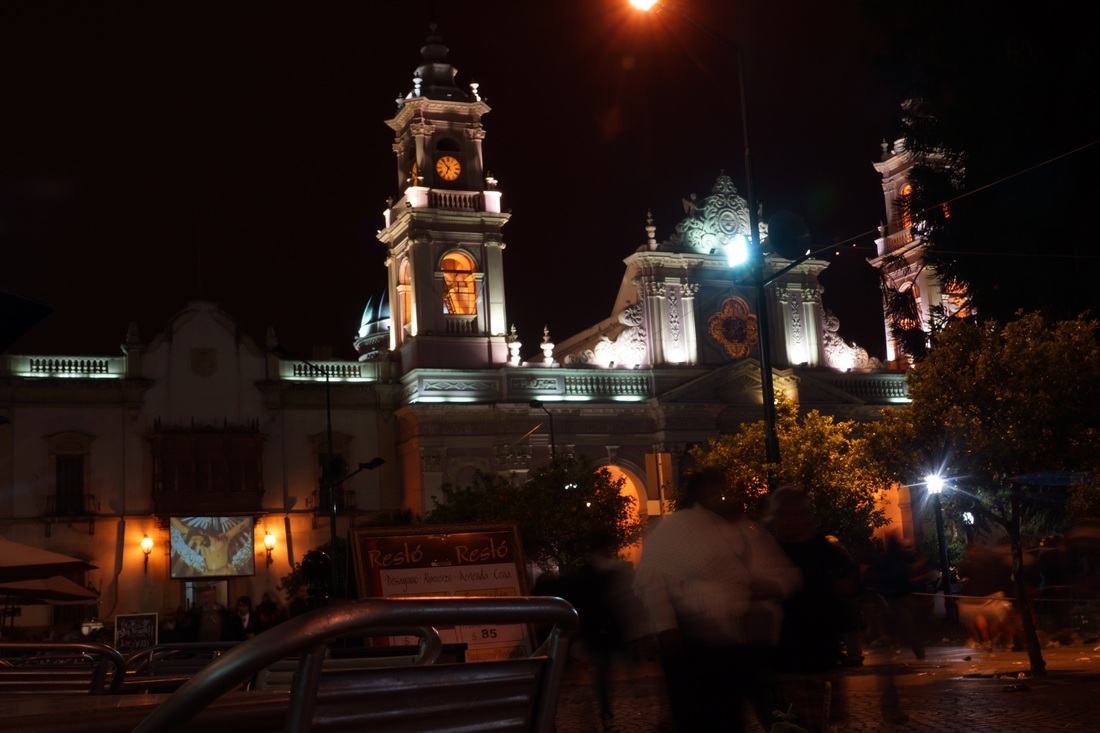 The cathedral in Salta As the plane came into Ezeiza International Airport one couldn't help but become aware of what a huge city Buenos Aires is. There is the city itself and then the suburbs and together they are called Greater Buenos Aires and half the population of Argentina live here. The other thing that you notice once you have landed and are on your way to your hotel is the sheer amount of traffic around and feel relief when you remember that you won't have to drive the motorhome through it. The traffic is fast and furious and unlike Estonia where you can happily walk into the traffic knowing it will stop here in BA you have to find some traffic lights and hope the traffic stops on red so you can safely cross and even then you walk pretty briskly. On our first full day in Argentina we were taken on an escorted tour of the city with an excellent guide called Mattias who comes from Quelfes which is also the home to Argentine's favourite beer. Our sight seeing included visiting the Cementario De La Recoleta which is where Eva Peron is buried. This cemetery is where the very rich and famous are buried in extravagant mausoleums which cost as much as an apartment in the more exclusive parts of BA. Eva Peron died of uterine cancer in 1952 at the age of 33 and the generals (with whom she was not popular) arranged for her to be buried in Italy under an assumed name and she was not brought to the Cementario De La Recoleta until 1974. If you know the words of the musical Evita then the Casa Rosada is a name familiar to you, this is where the president of the country works and it is located at one end of the Plaza de Mayo. Evita would give speeches to the 'shirtless ones' from here. The President still works there and Mattias explained that she lives 20kms out of town and comes to work by helicopter which lands in the Plaza and then she takes a car for the 100 yards or so to the Casa Rosada. Our trip also took us to the La Boca district, home to Boca Juniors football team and El Caminito which is a short street with very colourful houses made of corrugated iron and painted in vivid colours. A great tourist attraction now with tango dancers, street theatre, restaurants and gift shops. The district is called La Boca (the mouth in English) as it is at the mouth of the great River Plate. Boca Juniors is probably one of the more famous Argentinian football teams and its colours are blue and yellow. When the team was first constituted there was some disagreement as to team colours and so it was decided that the colours would be those of the flag of the next ship to come into the docks. It so happened that the next ship was from Sweden, hence the blue and yellow. As we headed into Puerto Madero for our lunch we passed a number of shanty towns, called favelas in Brazil but they are villas miserias here (villas being pronounced bishas here as the Spanish double LL is pronounced 'sh' here and 'v' is always 'b'). Lunch was at La Bisteca, a rather upmarket spot in the regenerated Docklands area. A huge buffet of food was available and I think our whole party ate heartily, which could have been a mistake as we are all scheduled to go out again later on tonight for another dinner. Below is a map showing our route on this tour, you can click on the pins and it will show you more info and if you manipulate the plus and minus signs you can alter the scale of the map. View Our Argentine adventure in a larger map Our South American adventure starts on 3 September with our flight into Buenos Aires where we will spend a couple of days before picking up our motorhome.
We expect to travel some 5000 kms in the motorhome before we give it back. For the first time ever we are travelling in a small group comprising seven motorhomes altogether. We are hopeful that our fellow motor homers are enthusiastic travellers like ourselves. |
AuthorThis is the travel blog of the MotorhomeDiaries and to read more about our travels in our motorhome go to our main web site. Archives
October 2013
Categories
All
|